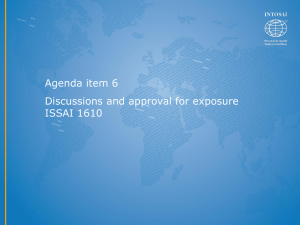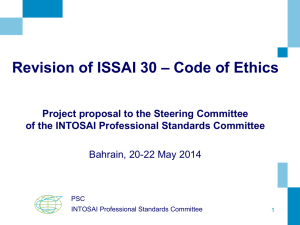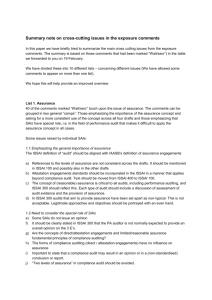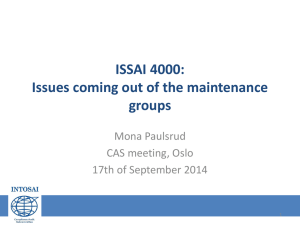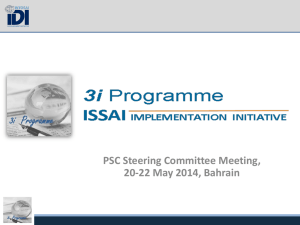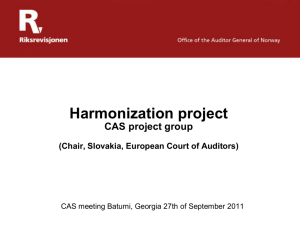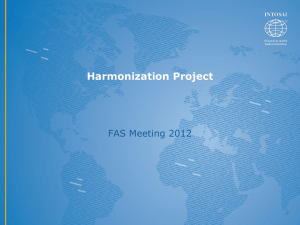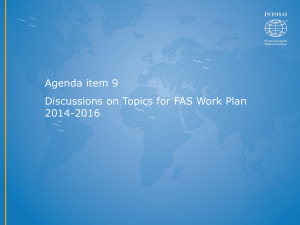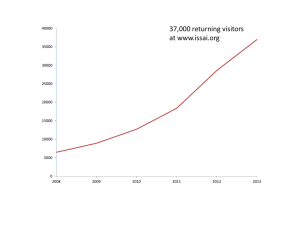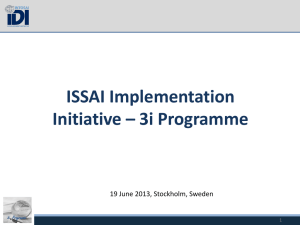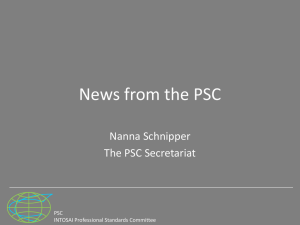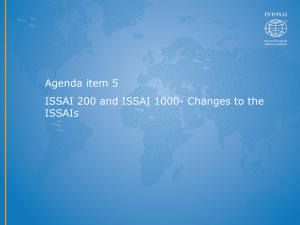Fundamental Principles of Public Sector Auditing for Supreme Audit
advertisement
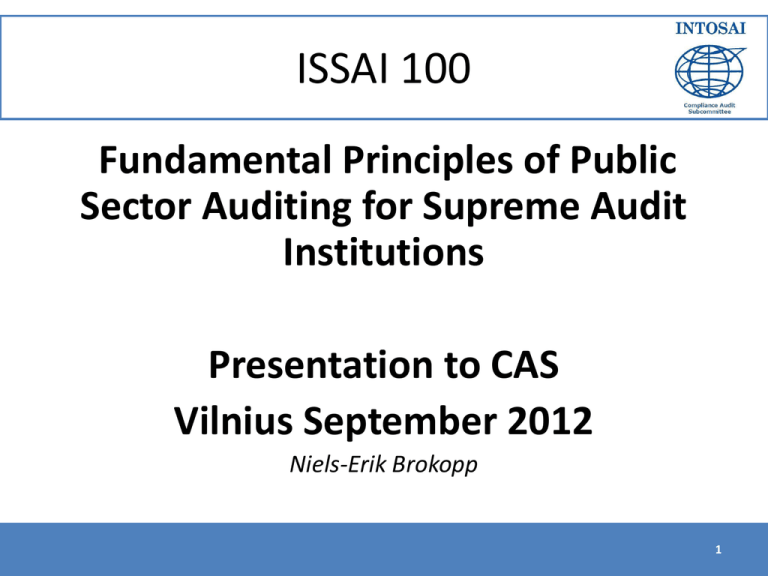
ISSAI 100 Fundamental Principles of Public Sector Auditing for Supreme Audit Institutions Presentation to CAS Vilnius September 2012 Niels-Erik Brokopp 1 Content • • • • • • • Purpose of the harmonisation project Where are we? Structure of level 3 Structure of ISSAI 100 Highlights What is not in? Next steps 2 Purpose of the harmonisation project • Overall objective: revise the text of ISSAIs 100-400 and develop the ISSAIs into a more coherent set of standards • 4 goals: A. Revise the ISSAI 100-999 Fundamental Auditing Principles on level 3 B. Make limited editorial changes in ISSAIs 10-99 on level 2 and improve consistency between the level 1 & 2 C. Ensure alignment with the ISSAI 1000-4999 Implementation Guidelines D. Consider alignment between the ISSAI 5000-5999 Specific Guidelines and ISSAI 100-4999 3 Where are we? • Goal A is in the process of finalisation – Draft ISSAI 100 was discussed in Washington (2011) and Copenhagen (2012) – Takes into account written comments from PSC SC – ISSAI 100 & 300 adopted for exposure by PSC SC from September 2012 to February 2013 – Final drafts of ISSAI 200 & 400 still to be approved by FAS and CAS • Goals B, C and D... 4 Structure of level 3 Old standards • ISSAI 100 “Basic principles” • ISSAI 200 “General standards” • ISSAI 300 “Field standards” • ISSAI 400 “Reporting standards” New Fundamental Principles • ISSAI 100 “...Public Sector Auditing” • ISSAI 200 “...Financial Audit” • ISSAI 300 “... Performance Auditing” • ISSAI 400 “... Compliance Audit” 5 ISSAI 100 - Structure • Structure agreed upon by project group in Copenhagen in May 2012 • ISSAIs 200-400 should aim at following a similar structure • • • Introduction Purpose and authority of the ISSAIs Framework for public sector auditing – – – – – – • Elements of public sector auditing – – – – – • Mandate Accountability, transparency, governance and performance Organisational requirements relating to quality control and ethics Objective Confidence and assurance in public sector auditing Types of public sector auditing The practitioner / auditor Responsible party Intended users Underlying subject matter and subject matter information Suitable criteria Principles to be applied in conducting an audit – – General principles Principles related to the audit process • • • • Activities related to planning the audit Activities related to performing the audit Activities related to evaluating audit evidence, concluding and reporting Making reference to the ISSAIs 6 ISSAI 100 – Highlights(1) • Introduction – the principles contained in ISSAIs 200-400 should be applied in conjunction with those presented in ISSAI 100 • Purpose and authority of the ISSAIs – difference between levels 1 and 2 which apply to the SAIs as institutions and 3 and 4 which apply to the auditor • Framework for public sector auditing – recognition of the differences in the perception of what auditing is, which depends on mandate, strategic decisions or organisation – reminder of the most important organisational requirements for the SAIs: ethics and quality control – objective of auditing and public sector auditing 7 ISSAI 100 – Highlights(2) • Confidence and assurance in public sector auditing – a sub-group consisting of PAS, FAS and CAS representatives was formed to write this section – recognises that assurance or confidence can be presented in different forms, not exclusively in an opinion • The elements and the principles to be applied – common issues for the three audit types: elements relating to a public sector audit situation principles when conducting an audit divided into two groups: o general principles; and o principles applicable to the phases of the audit process • Making reference to the ISSAIs – text agreed by the “authority” sub-group and which should be repeated in ISSAIs 200-400 – two ways to use the principles: either to form the basis on which standards are developed or adopted or to form the basis for the adoption of the general auditing guidelines at level 4 as the authoritative standards 8 ISSAI 100 – What is not in? Examples of issues/principles not covered or reduced drastically: • Sampling which has its own principle in the Lima declaration has not been brought forward to ISSAI 100 • Reporting from ex-ISSAI 400 has only to a small extent been taken into account in ISSAI 100 – up to FAS/PAS/CAS to incorporate important elements in 200/300/400 9
